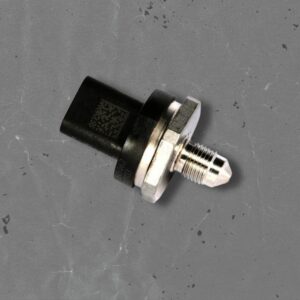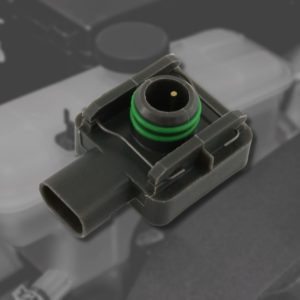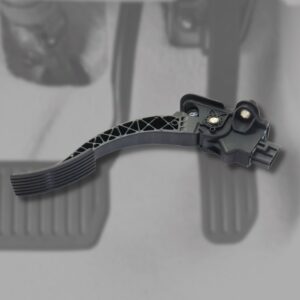Vehicles are one of the biggest contributors to air pollution. Approximately 51% of carbon monoxide pollution is attributed to motor vehicle use. It’s tricky to balance, but in this day and age, it’s crucial to help conserve our environment while still adhering to the needs of society.
One component that has helped automakers ensure that their vehicles run more efficiently is the DPFE sensor.
What Is a DPFE Sensor?
The DPFE (Differential Pressure Feedback Electronic) sensor is a component of the exhaust gas recirculation (EGR) system. Its primary function is to monitor and measure the flow of exhaust gas recirculation in the engine.
How Does the DPFE Sensor Work?
The DPFE sensor is a small device usually mounted on the engine. It has two small tubes connected to the exhaust manifolds or pipes. These tubes are exposed to the exhaust gasses before and after entering the EGR valve.
The sensor sends information to the powertrain control module (PCM) and tells it how much exhaust gas flows through the system. Based on the data, the PCM assesses the flow and regulates it using the EGR control valve.
Exhaust gasses are redirected to the combustion chamber for re-burn. This prevents detonation and the formation of NOx gasses which are harmful to the environment. Similarly, allowing already burnt exhaust gas into the chamber lowers the temperature of the process.
Symptoms of a Bad DPFE Sensor
Some common symptoms of a failed DPFE sensor include reduced engine performance, poor fuel economy, failed emissions tests, an illuminated check engine light, misfires, rough idling, and hesitation.
Reduced Engine Performance and Fuel Economy
A malfunctioning DPFE sensor may contribute to reduced engine performance, as it can possibly send incorrect information to the PCM. Incorrect calculations from the vehicle computer may cause excessive fuel consumption. At the same time, the engine may need to work harder to compensate for the faults.
Failed Emissions Tests
Every state has laws regarding emissions tests that are often required for registration. While there are several possible reasons for failing emissions tests, one thing you should watch out for is a failed DPFE sensor.
NOx levels are typically checked during emissions tests. This sensor is required for the EGR system to reduce the levels of Nitrogen Oxide (NOx) emitted by the engine.
Additionally, if there’s a problem with the DPFE sensor or the EGR system, there will likely be stored trouble codes.

Illuminated Check Engine Light
The check engine light illuminates when the vehicle computer or one of the other modules detects a possible issue within the vehicle. Since the DPFE sensor relays information to the PCM, the latter can activate this warning light if the sensor is sending irregular signals or isn’t sending information at all.
Keep in mind that more than one issue can trigger the check engine light, so it’s best to check for other symptoms before chalking it up as a faulty DPFE sensor. One of the best ways to verify what’s causing the error is by retrieving the trouble code using an OBD-II code scanner.
Misfires
A faulty DPFE sensor may signal that there’s not enough gas flow, prompting the PCM to open the EGR valve when it shouldn’t. This may result in a lean condition, which is when there’s too much air or not enough fuel in your engine.
Eventually, the condition may trigger either a P0171 or P0174 code. A shared symptom of these two codes is misfires. This describes a condition when the internal combustion engine fails to ignite properly or at the right time.
Misfires may also affect your vehicle’s fuel economy, as the engine burns more fuel than intended to make up for the incorrect ignition timings.
How to Diagnose the DPFE Sensor
Before you diagnose a DPFE sensor, you should always follow the flow chart. Avoid disconnecting hoses or anything until you’ve done testing. Disconnecting them could cause them to split and result in you replacing the hoses.
Before you diagnose a DPFE sensor, you should always follow the flow chart.
–Anthony Harlin, ASE Certified Master Automobile Technician
With that said, there are a couple of ways to diagnose or repair DPFE sensor issues. The first one is by using a vacuum line splitter to split the line and insert anything that fits to stop exhaust gas recirculation.
The second method is to remove the hoses from the DPFE sensor and then re-attach the EGR valve hose to the “Ref” hose port on the sensor. This can trick the system so that instead of opening the EGR valve, the PCM will apply a vacuum to the reference sensor for the DPFE.
This results in the “Hi” sensor seeing more pressure than the reference sensor, tricking the PCM into thinking the valve is working properly. This trick can help you identify if the sensor is completely damaged. If it is, the dashboard should notify you of insufficient or excessive EGR flow.
What to Do if the DPFE Sensor Is Faulty
The best thing to do if you suspect a faulty DPFE sensor is to have a mechanic take a look and diagnose the issue. The worst-case scenario is you’ll have to replace the sensor, but that should only cost you somewhere between $130 and $150.
Any information provided on this Website is for informational purposes only and is not intended to replace consultation with a professional mechanic. The accuracy and timeliness of the information may change from the time of publication.
































